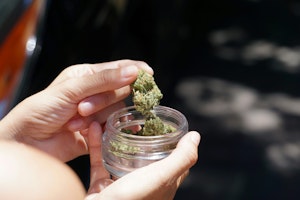
Photo by Cottonbro Studio
Weed For Relief: Can CBD & THC Help With Pain Management?
CBD and THC users are eager to spread the word about the pain-relieving benefits of these cannabinoids.
CBD is highly regarded for its therapeutic properties. Those who use it regularly report that it helps reduce anxiety, stress, sleep disorders, and pain relief. But even though many say so, it’s taken long enough for research and studies to verify whether cannabis can be used to treat various health conditions, like chronic pain.
But times have changed, and CBD is now very popular and, more importantly, legal. Although its counterpart, THC, is not legal, anecdotal reports and various studies have verified that THC and CBD can be effective remedies for pain management. Interestingly, both of these naturally occurring cannabinoids can be even more effective when used together, producing the entourage effect.
As more research unfolds, there’s more information to spread about these two cannabinoids. That’s why we’ve created this guide to take a closer look at CBD and THC for chronic pain management.
CBD & THC Explained
Believe it or not, CBD is another addition to the growing list of 113+ cannabinoids identified and found within the cannabis plant. Perhaps the most famous among them is THC, the psychoactive component found in weed responsible for the infamous high. On the other hand, CBD does not cause a high.
CBD can be found in marijuana plants but is found in larger quantities within the non-psychoactive version of the cannabis plant, known as hemp. Hemp contains less than 0.3% THC, which explains why its harvest and use are legal in all 50 States across the U.S.
Consequently, CBD derived from hemp sources is also legal in all 50 states. This includes concentrates, flower, oil, and any other ramifications that stem from it. THC products can be legal only if they contain equal to or less than 0.3% THC per dry weight of the product.
Benefits, Effects & Properties of CBD & THC
The effects of CBD and THC on the body can vary and largely depend on the subject’s specific case. Typical effects and properties recorded anecdotally among CBD users include:
- Anticonvulsant
- Antiemetic
- Antioxidant
- Anxiolytic/Antidepressant.
- Anti-inflammatory
- Positive effects associated with pain management
CBD is mostly safe for use in most subjects; this also includes mammalian pets like cats and dogs. However, every case is different, and before dosing your pet or yourself with any amount of CBD, you should first ensure that your product is legit, lab-tested, and certified for quality and purity.
THC, on the other hand, has been known to provide the following health benefits:
- Pain relief
- Reduced insomnia and better sleep
- Reduced nausea
- Increased appetite
- General happiness
- Physical and mental relaxation
Topical Products
What Is The Best Way To Consume Cannabis For Pain?
Given the long list of potential benefits and product formats, it’s necessary to choose a suitable consumption method to treat particular forms of pain. Pain is divided into four major types:
Nociceptive Pain: Resulting from tissue injuries, like arthritis pain, mechanical pain, or post-surgical pain.
Inflammatory Pain: Any inflammation caused by a response of the body’s immune system.
Neuropathic Pain: Pain caused by nerve irritation
Functional Pain: This type of pain doesn’t have an obvious origin but includes conditions like IBS and Fibromyalgia
CBD’s anti-inflammatory effects, paired with the general pain-relieving effects of THC, have been found to help with all these types of pain responses at different levels. When it comes to nociceptive pain, the most efficient way of treating focused areas of the body is using oils and salves made with full-spectrum (THC-containing) CBD extract that can attack a specific area of the body.
However, nociceptive pain is not always stagnant and can move throughout different areas of the body. Not only that, but when dealing with any kind of pain, users often look for the quickest way to treat it.
The consumption method with the quickest onset is often attributed to inhaled methods. This could be vaping cannabis flower or extracts or smoking cannabis flower using a joint or bong.

Photo by Victor Moussa / Adobe Stock Photo
What Dose Should I Take?
We can’t stress enough that dosing CBD and THC, or any alien substance to the body depends entirely on your specific condition and the types of symptoms you suffer from. However, there are standards that we can benchmark off of.
When it comes to concentrates and pure extracts, the usual recommendation is to start out with lower-end doses around the 20mg mark and then slowly work yourself up from there as you see fit. Some people take more than 60mg of CBD or THC daily, but it’s probably best to pace yourself. At the end of the day, we’re playing a long game here when it comes to chronic pain.
Flower allows you to be a bit more flexible with dosing. Not because it’s a less effective or potent way to consume cannabis, but on the contrary, because it carries a faster onset and bypasses the intestinal tract.
Conclusion
Cannabis shows a lot of potential as an alternative aid in pain relief. Anecdotal evidence has been recorded from frequent and new users that suggest the substance can be beneficial to patients suffering from chronic pain.
It’s necessary to point out that conclusive evidence is not available with today’s existing research, but anecdotal evidence is promising and the results recorded are seldom negative.
CBD is a non-psychoactive component of the cannabis plant. A feature that has made it increasingly coveted among users that would like to benefit from its anti-inflammatory and pain-suppressing effects without the need for a body and mind-impairing feeling.
THC, on the other hand, offers that well-loved sensation of euphoria, which directly contributes to overall happiness and well-being while reducing pain. It’s clear that both cannabinoids are effective for chronic pain, so which will you choose? (Tip, we suggest both).
Herb Recommended Products:
READ MORE










